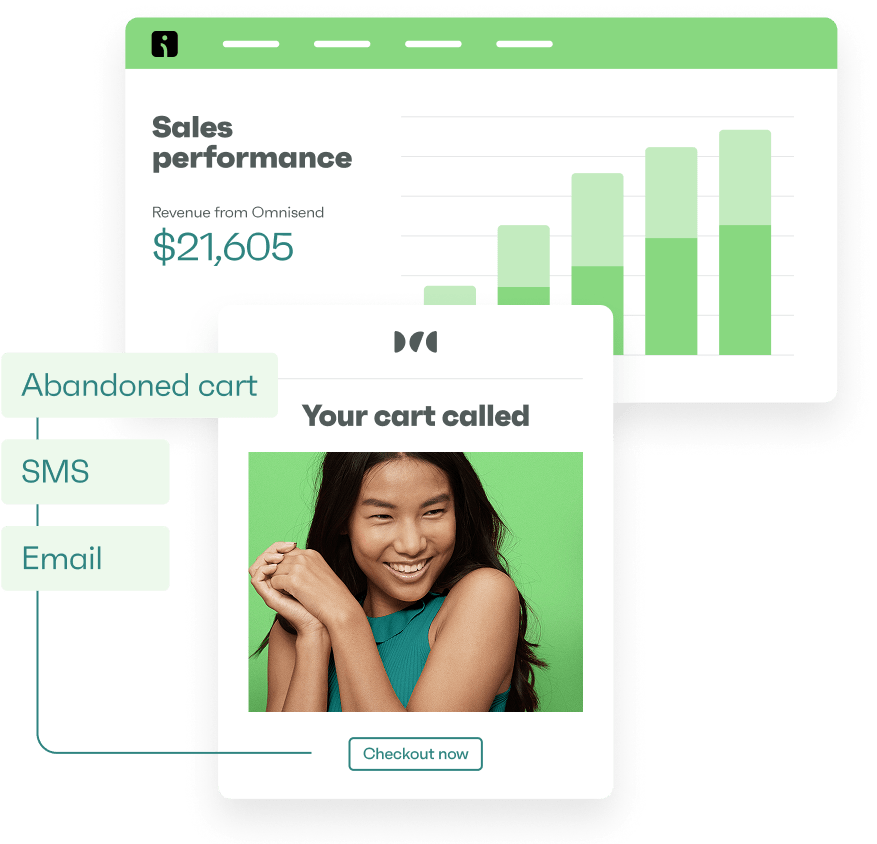Drive sales on autopilot with ecommerce-focused features
See FeaturesMobile traffic now accounts for well over half of web traffic. It’s safe to assume then that your customers use smartphones more than any other device, and with a strong mobile marketing strategy, you won’t miss any opportunities to connect with them.
Building a mobile strategy matters because your SMS, push notifications, and content must work together at optimal moments without overwhelming customers or competing for attention across their buying journey.
This article is a complete guide to mobile marketing strategy, including what it is, techniques and tactics, real-world examples, and how Omnisend fits into the picture.
Quick sign up | No credit card required
What is a mobile marketing strategy?
A mobile marketing strategy is a plan for reaching customers on their smartphones, tablets, or other handheld devices via the apps and channels they use to make purchases.
A quick example
Your customer adds items to their cart but leaves without buying during a mobile shopping session. Your marketing app triggers an abandoned cart SMS automation five minutes later, with the message, “You left items in your cart. Complete your order with 10% off: [link].”
In this case, the strategy is to recover lost revenue, and a text message is the best channel because the customer was using their smartphone.
Benefits of mobile marketing strategies
Creating a mobile marketing strategy will help you:
- Reach customers within minutes instead of hours via SMS
- Cut marketing costs by eliminating design needs for text campaigns
- Match natural phone-checking habits with timely offers
- Convert impulse decisions with one-tap purchasing
- Build loyalty through personalized, location-aware messaging
Omnisend automates mobile marketing across channels. It lets you set up email and SMS marketing flows for cart recovery, create campaigns that display flawlessly on small screens, and trigger personalized messages for different customer segments.
Why mobile marketing strategies are essential in 2025
Your customers live on mobile devices. Omnisend’s 2025 report analyzed 230 million SMS messages and 413 million push notifications, revealing mobile marketing’s explosive growth and proven results.
The numbers prove mobile’s dominance:
- SMS volume increased 31% year-over-year
- Push notification usage grew 55%
- SMS automations achieved 147% higher click rates than campaigns
- One in three people who clicked automated mobile messages made purchases
- Push notification conversions reached 60% in France and 51% in Australia
Why businesses invest in mobile
Mobile marketing solves different challenges across business types. Direct access to customers eliminates intermediaries and ad platform algorithms. Message delivery happens in seconds, not hours or days.
The immediacy matters most. Cart abandonment SMS reaches customers while purchase intent remains high. Flash sale push notifications arrive during active browsing. Location-based offers appear when customers pass nearby stores.
The consumer shift you can’t ignore
Mobile-first is how we live now. Email and message checks happen on phones before getting out of bed. Many of us compare prices while in-store using our phones. Shopping apps, such as Amazon, are now search engines for product research.
Ignoring mobile in your marketing strategy means missing these high-intent moments when customers need immediate answers or offers.
Top mobile marketing strategies for 2025
SMS, push notifications, and in-app messaging are just a few types of mobile marketing that serve different purposes. SMS brings back abandoned carts. App rewards build loyalty. Push notifications generate urgency. QR codes bring traffic to your campaigns.
No single type works alone — most successful brands combine several of these strategies to maximize success.
Here’s a breakdown of some of the best mobile marketing strategies for your business:
SMS and MMS marketing
SMS delivers text messages to phones. MMS adds images and videos. Most people read texts within minutes of receiving them, ideal for time-sensitive communication.
Ecommerce uses include reminders, shipping notifications, flash sale alerts, and cart recovery messages an hour after abandonment. Visual MMS showcases new arrivals or demonstrates product features more clearly than text descriptions.
Here’s an example SMS for a “subscribe & save” reminder:
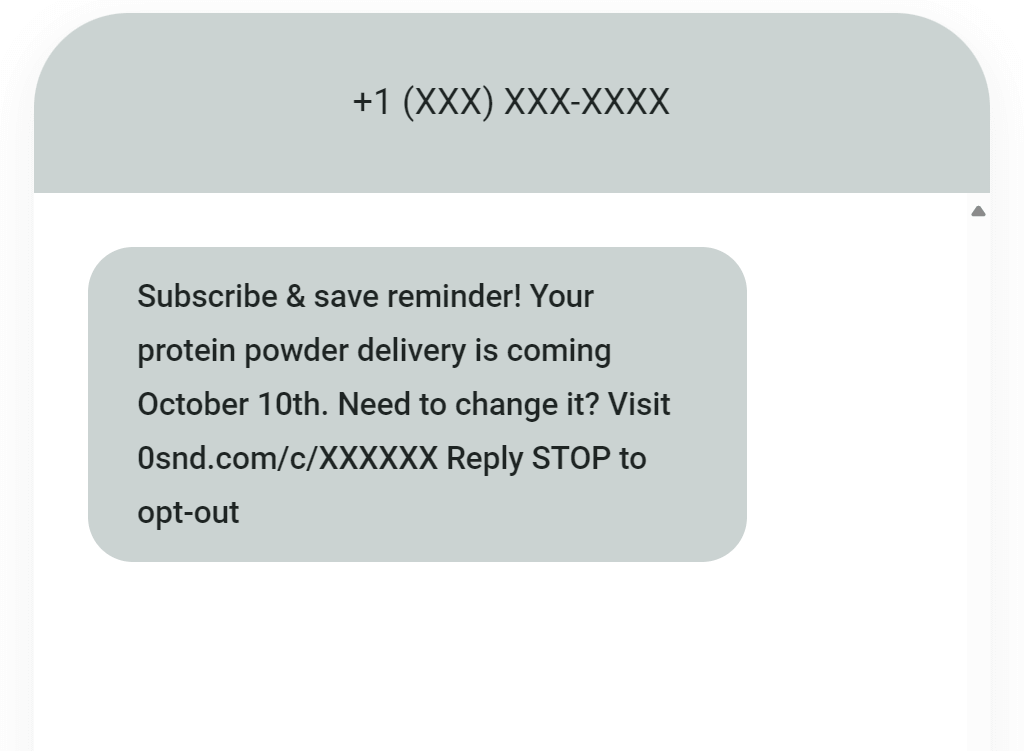
SMS forces you to say everything in 160 characters. Go over and your message splits, costing double. MMS lets you add images and more text, but carriers charge premium rates. Plus, regulations demand opt-in consent and unsubscribe links in every message.
Follow these best practices to make the most of SMS/MMS marketing:
- Write concisely: SMS splits at 160 characters, so every word must count
- Include visual content: MMS showcases products better than text descriptions alone
- Time for relevance: Send lunch deals at 11 AM, evening sales at 7 PM
- Personalize messages: “Sarah, your saved items are on sale” outperforms mass texts
- Create urgency: Flash sales need deadlines like “Sale ends at 2 PM” rather than vague warnings
- Enable easy opt-out: Include “Text STOP to unsubscribe” in every message since compliance isn’t optional
- Test different approaches: Your audience might prefer discount percentages over dollar amounts, but only testing reveals what works
- Control frequency: Monthly, weekly, and daily messages suit different audiences
Omnisend handles the technical complexity of SMS/MMS campaigns. Set behavioral triggers for abandoned carts, create segments for VIP customers, and track which messages generate revenue. It also manages compliance requirements automatically.
Watch this video for more top SMS marketing tips:
Good to know
Omnisend integrates with Wix, Shopify, WooCommerce, and more leading ecommerce platforms with native apps:
Mobile app marketing
Apps create direct connections with your best customers who check them for rewards, receive push notifications about sales, and shop without entering passwords each time.
All that interaction provides behavioral insights you can use across other channels, such as which categories customers browse most, their preferred shopping times, and price points that convert.
The challenge lies in convincing customers to download another app when storage space is precious. Also, apps have significant developer costs, and you’ll need to update them routinely to comply with app store guidelines.
Here are the best tactics for mobile app marketing:
- Push notifications: Send cart recovery messages within an hour for best results, time flash sales to match when your customers actually shop, and convert wishlist browsers with price drop alerts
- In-app messaging: Browsing sessions last longer with relevant product suggestions, and cart values increase when you recommend items that complement what’s already there
- Email marketing: Send mobile app emails when you have news and updates to share
- Loyalty programs: Home screen point displays keep your brand visible daily, plus redemption without codes or email searches means rewards actually get used
- App exclusives: Some products only live in your app to create download urgency, and you can offer early access to keep the app from getting deleted
Here’s an example — Footlocker’s app has competitions for new releases:
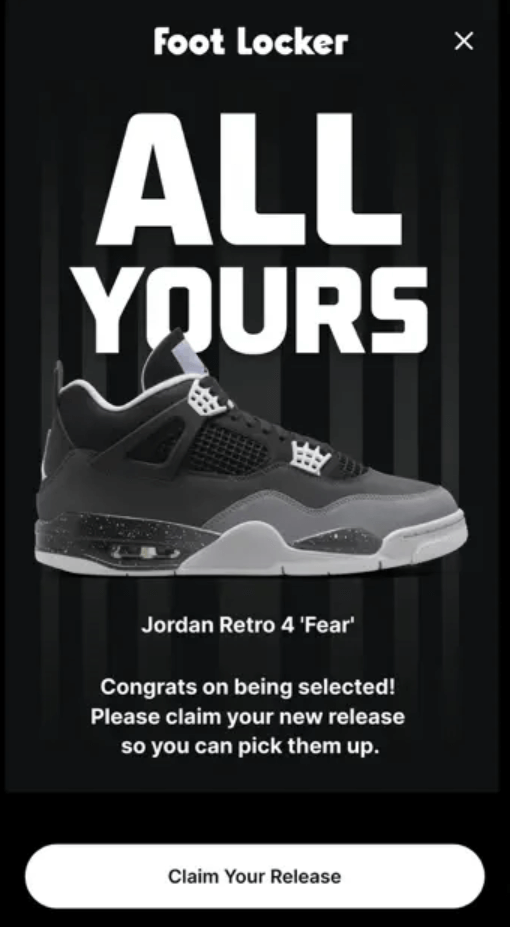
- Gamification: Free shipping progress bars add that extra item to carts, and milestone badges turn one-time buyers into regulars
- Location features: “Order ready” alerts respect customer time, and inventory checks save disappointment from empty shelves
Social media marketing on mobile
TikTok, Instagram, Facebook, Snapchat, and all other social media platforms have apps. Additionally, all receive their most significant share of web traffic on mobile, not desktop.
What’s the takeaway? It’s that smartphones are the device to target in your social media efforts.
You have two approaches to capitalize on it:
- Paid ads that target new customers and promote sales
- Organic posts that build community and brand awareness
Here are the best mobile social media tactics you can use to improve your paid and organic campaigns:
- Vertical video formats: TikTok and Instagram Reels need a 9:16 ratio content because that’s how people hold phones, so shoot everything vertically from the start
- Instagram Stories features: Build engagement with polls, competitions, and flash sales with 24-hour expiries
- Influencer and sports partnerships: Collaborating with accounts your customers already follow generates trust and relevant traffic.
Here’s how Starbucks recently announced its Team USA partnership on TikTok:
@starbucks It’s official: Starbucks is the official coffee partner of Team USA and LA28 Olympic Games.
♬ original sound – Starbucks
- Time-limited posts: Flash sales on Stories that vanish tomorrow outperform permanent feed posts for driving immediate action
- Interactive elements: Quiz stickers match customers with products, question boxes collect content ideas, and polls have high engagement rates
- Customer photos: Reposting buyers wearing your products provides social proof, and branded hashtags encourage more sharing
- Behind-the-scenes content: Showing production processes or order packing humanizes your brand beyond product shots
- Shopping tags: Instagram and Facebook let customers purchase directly in-app, removing steps between discovery and sale
Location-based and proximity marketing
Location marketing divides into two categories:
- GPS-based targeting reaches customers within miles of locations
- Proximity marketing connects with devices within feet using Bluetooth or NFC
GPS-based targeting
GPS uses phone location services to deliver messages when customers enter predefined zones. You create virtual boundaries around stores, competitors, or high-traffic areas.
A few applications include:
- Store alerts: Send offers when customers pass within two miles of your location
- Competitor targeting: Message shoppers at rival stores with better deals
- Event marketing: Reach conference attendees with booth locations or special offers
- Transit campaigns: Target commuters at specific stops during rush hour
- Weather triggers: Push raincoat deals during storms in affected ZIP codes
However, there are some drawbacks:
- Coverage spans broad areas, but precision suffers
- Messages might reach someone two blocks away who can’t visit immediately
- Privacy concerns could equal complaints
- You risk annoying customers with unsolicited marketing messages
Proximity marketing
There isn’t an enormous radius here. You’re looking at around 300 feet via beacons, NFC tags, and Wi-Fi to trigger in-store messaging and alerts on smartphones.
Proximity tactics to consider:
- Entrance detection: Greet customers with today’s deals upon arrival
- Aisle assistance: Help shoppers find products or notify them about relevant sales
- Line management: Engage waiting customers with entertainment or exclusive offers
- VIP alerts: Notify staff when loyal customers arrive for personalized service
- Exit surveys: Request feedback or provide next-visit incentives as customers leave
Some of these ideas require customer app downloads, opt-in, and are dependent on Bluetooth and other connections. Consider whether your customer base and store traffic justify the investment in proximity technology before making a decision.
Mobile-friendly websites and landing pages
Your website is where mobile marketing campaigns land. If pages load slowly or buttons are too small, you’ll lose customers, regardless of how effective your SMS or ads may be.
Speed optimization tactics
- Compress media: Images at 80% quality look identical, but load faster
- Lazy load below fold: Product images further down the page load as customers scroll
- Minimize code: Remove unused CSS and JavaScript that bloats page weight
- Choose fast hosting: Server response time impacts everything else you optimize
- Minimize apps: Use only the apps you need and pick fast ones
- Omnisend runs from its own dashboard without adding code to your site, so it has a negligible impact on site performance
- Cache static content: Returning visitors see instant loads when assets are cached
Run your site through a website speed testing tool to identify areas for improvement. Speed optimization tools worth your time include PageSpeed Insights, Pingdom, and GTmetrix.
Mobile design principles
- Touch targets matter: Fingers are bigger than mouse cursors, so space elements accordingly
- Vertical layouts win: Stack content in single columns rather than side-by-side grids
- Extra form fields kill conversions: Each field you add reduces completion rates
Omnisend lets you configure fields, add multiple steps, and all forms and popups automatically resize for mobile screens. Here’s an example:
Mobile form
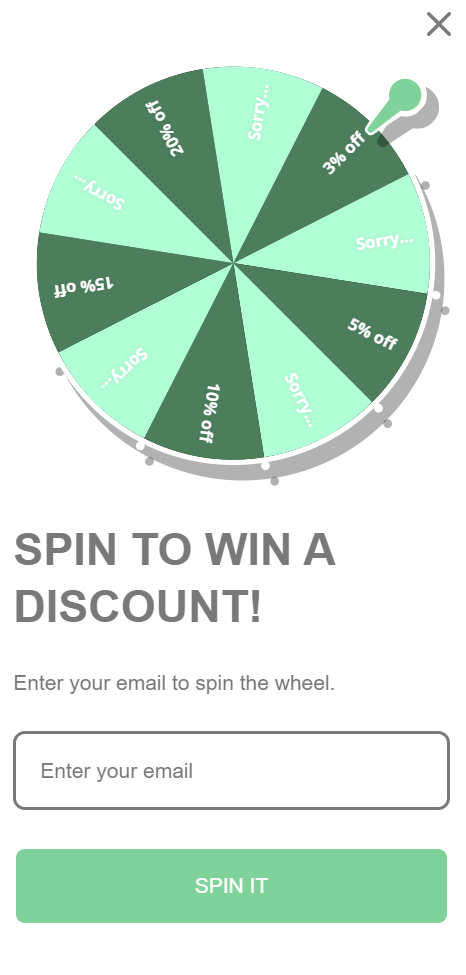
Desktop form
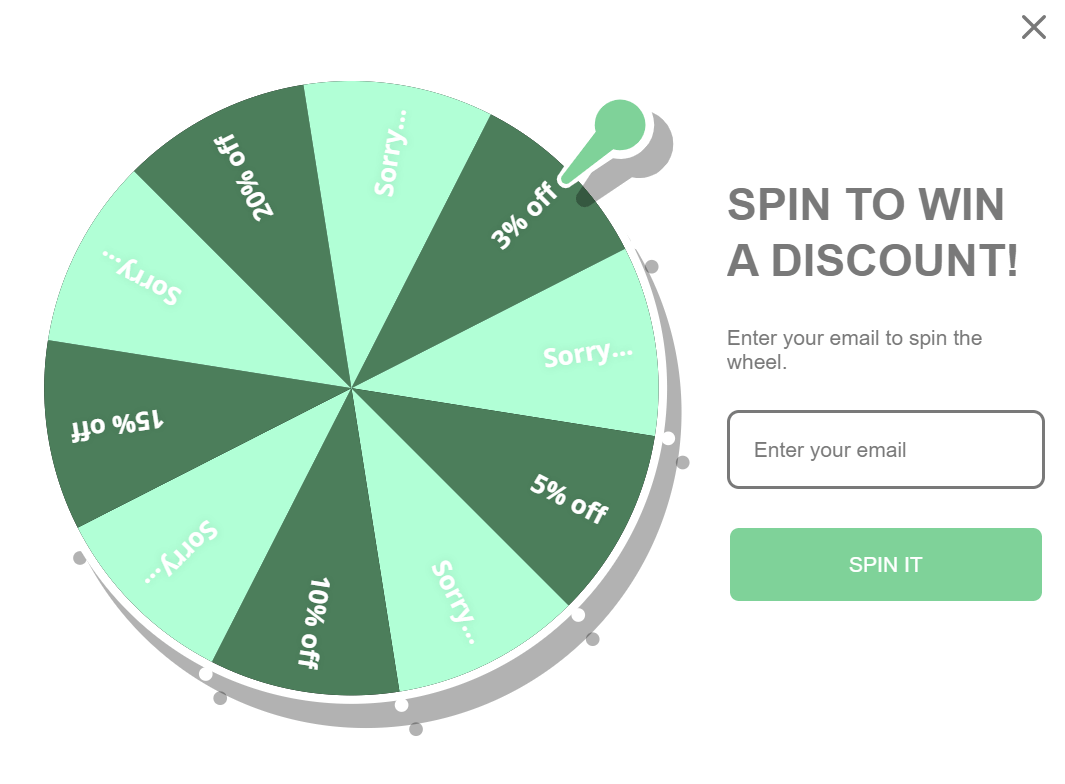
- Contrast aids readability: Light gray text on white backgrounds frustrates mobile readers
- Navigation stays hidden: Hamburger menus save precious screen space for products
- Make changes with data: Use website analytics and heat maps to identify improvements you can make to your website
Omnisend provides analytics for email and SMS marketing, helping you discover your most effective campaigns and automations.
Top tip
Platform limitations vary. Some ecommerce CMSs restrict speed optimization and design customization options. Check whether your platform allows custom code, image optimization, and layout modifications before committing.
QR code marketing
QR codes let customers scan their way to exclusive offers, product details, or instant purchases. Phone cameras read these square barcodes in seconds, eliminating the need for typing URLs.
Where to use QR codes
- Product packaging: Link to assembly videos, recipes, or reorder pages
- Social media posts: Share QR codes that feel exclusive, such as this one from Coca-Cola on Instagram, confirming its Roadshow dates with a free custom can offer:
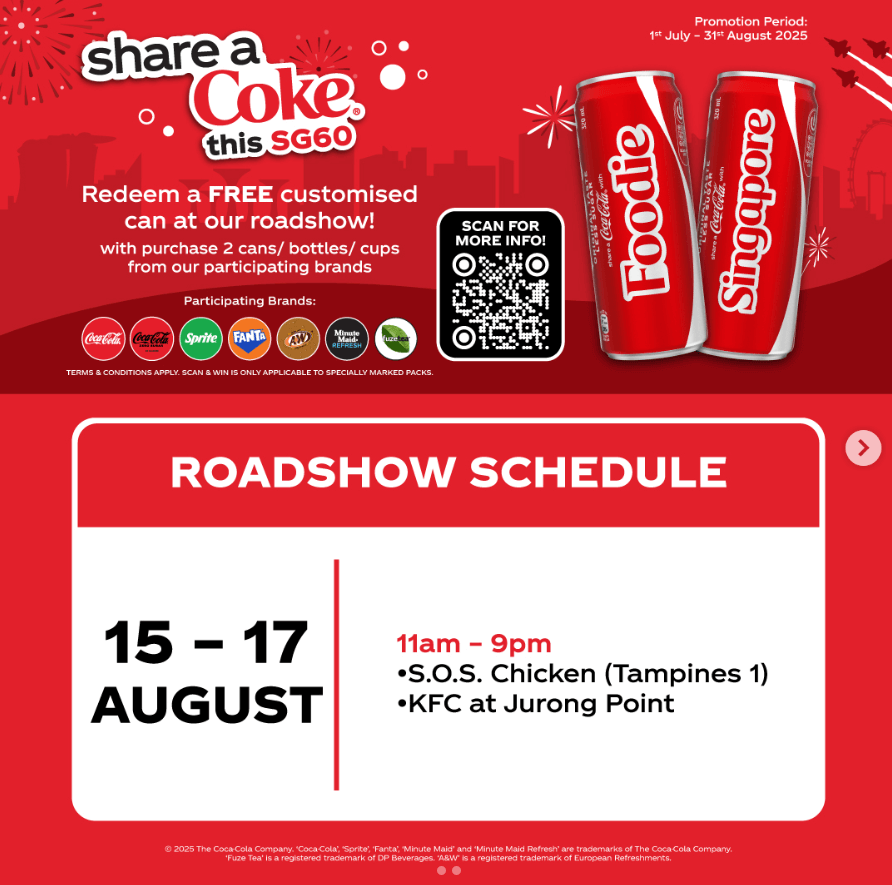
- Order confirmations: Let customers track shipments with one scan
- Loyalty cards: Digital punch cards that live in phone wallets
Making QR codes work
- Reward the scan: Exclusive content justifies the effort of pulling out a phone
- Ensure visibility: One-inch minimum size prevents scanning frustration
- Test everything: Different phones and apps read codes differently
- Explain the benefit: “Scan for free shipping” tells customers why they should bother
- Monitor results: Each campaign needs its own code for tracking what converts
Place QR codes wherever customers already engage with your brand. They turn static content into interactive experiences, whether on packaging, screens, or print materials.
Mobile marketing techniques and tips to maximize results
So, how to do mobile marketing? The first step is choosing the channels your customers use most. The next steps include aligning timing, content, and context across those touchpoints to encourage engagement.
Here are 12 techniques and tips to use in your mobile-first marketing strategy:
- Take an omnichannel approach: SMS, email, and web push notifications can work together in automations rather than as standalone elements. They trigger based on the conditions you set to reach customers at optimal moments.
- Send campaigns at optimal times: The prime time for email open rates is 8 PM. For SMS, 5 PM to 9 PM is best for regular promotions.
- Include customer names in messages: Adding a name to subject lines can have a positive impact on email open rates. The same can be said for engagement rates in texts and push notifications.
- Segment by purchase behavior: Create groups based on buying patterns. High spenders get VIP treatment, one-time buyers receive win-back offers, and frequent shoppers see loyalty rewards. Omnisend segments automatically update with customer behavior. Create segments once, then they stay current without manual updates.
- Reference previous engagement: Use purchase history and browsing data for relevant messaging and product recommendations. Someone who browses winter coats gets coat promotions, not swimwear deals.
- Design CTAs for thumbs: Make buttons 44×44 pixels minimum. Center them where thumbs naturally rest and use actionable language, such as “BUY NOW.”
- Create authentic urgency: Use inventory levels or shipping cutoffs in messaging. For example, say “Two hours until overnight shipping deadline.”
- Test multiple message variants: A/B test different elements to find what works. Test “Flash Sale Today” against “24 Hours Only: 50% Off” in subject lines. Compare sender names, email content, and even entire design layouts.
- Track attribution: Customers discover you on Instagram, join your email list, and buy via SMS. Miss any touchpoint and you’ll cut winning channels, thinking they don’t convert.
- Plan for poor connections: Some of your customers will have spotty data. Text loads everywhere, images don’t. Build SMS campaigns that work without media. Add alt text to describe the image content for failed loads.
- Create mobile-only value: Generic “10% off” emails train customers to ignore you. SMS subscribers getting exclusive two-hour flash sales stay engaged. Exclusivity maintains opt-ins.
- Monitor and optimize frequency: Daily texts and emails annoy people. Find your audience’s tolerance by testing and monitoring unsubscribe rates.
Mobile marketing for new business and product launches
Mobile marketing gives your new ecommerce store and product launches direct customer access without massive budgets. For instance, SMS costs are around $0.015 per message per recipient in the USA, and push notifications are free.
Mobile marketing for new businesses
Your new store needs customer data from day one. Mobile numbers provide direct access that email can’t match, making SMS collection your priority.
Start with SMS collection at checkout
Collect mobile numbers using a simple value exchange. Offer 10% off their next purchase for SMS opt-in, then deliver that welcome discount within 24 hours to establish trust immediately and begin the relationship positively.
Build weekly SMS rhythms
Send exclusive deals on the same day each week. Tuesday might become your SMS day with subscriber-only offers. Keep messages short with clear links, such as “Today only at yourstore.com/tuesday” that load directly to products.
Here’s an example of a weekly text message offering $10 off orders over $60:
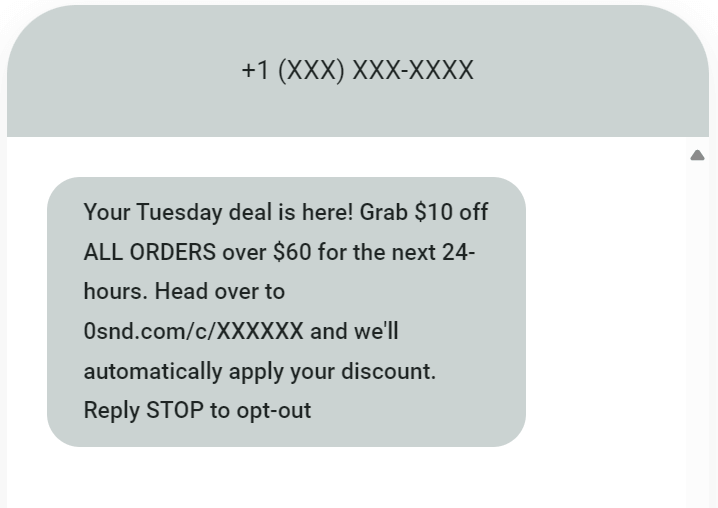
Optimize for mobile visitors immediately
Mobile site optimization can’t wait. Your customers find you via social links or Google on their phones. They judge in seconds based on load speed and navigation. Complicated menus and missing payment options can lead to lost sales.
Mobile marketing for new product launches
Your product drops require different tactics than ongoing operations. The limited window demands aggressive mobile strategies that build excitement quickly.
Create pre-launch anticipation
Product launches benefit from mobile’s real-time reach. Start building anticipation two weeks early with cryptic messages. “Something special coming 11/15” plants seeds. Follow with MMS glimpses showing just enough detail to spark discussion.
Reward loyalty with early access
Text your SMS list exclusive codes 24 hours before the public launch. They feel valued while you test demand and build social proof. Launch morning brings the full reveal with direct purchase links, catching customers during their morning scroll when excitement peaks.
Check out this SMS example promoting a new sneaker launch:
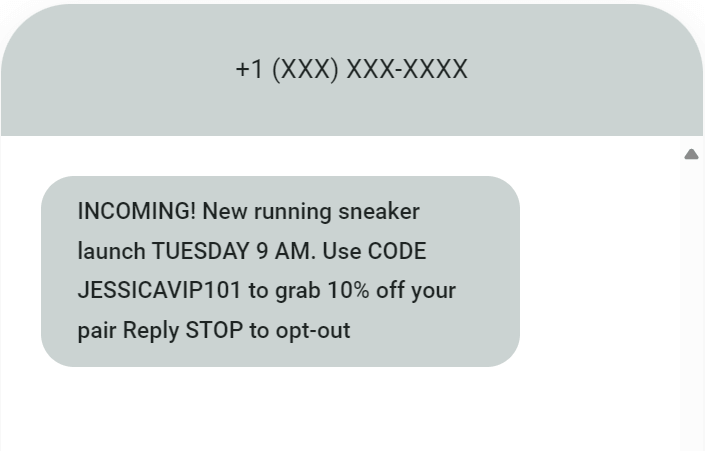
Maintain launch day momentum
Sustain energy across marketing channels. Midday messages update stock levels. Push notifications with images remind app users about availability. Evening SMS targets window shoppers with last-chance offers. Each message moves customers toward purchase decisions.
How to create a mobile content marketing strategy
Your customers read on phones between tasks, so you need scannable, easily-digestible content that works in these moments.
Mobile-first content formats
Build content for immediate understanding and action, such as:
- Short-form blogs: Keep blogs under 500 words and consider using videos and animations to improve engagement. Nike nails this strategy through its Stories blog, covering the athletes who use its products. The example below, featuring Boxer Cindy Ngamba, has fewer than 150 words and a video:
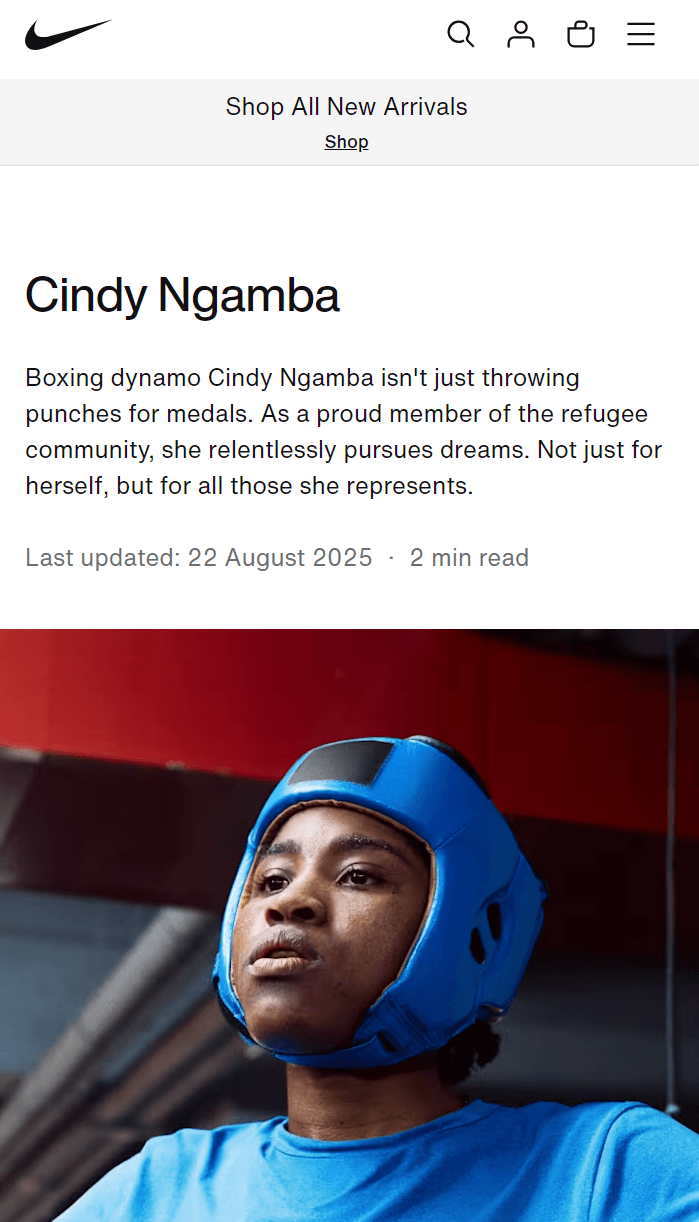
- Vertical videos: Film products in 9:16 format. Thirty-second clips showing products in use generate more sales than studio photography. Add captions for silent viewing.
- Graphics: Product comparison charts, size guides as visuals, ingredient lists as icon grids. Visual content gets saved and shared.
- Instagram stories: Post flash sales, time-limited discount codes, and product previews that disappear after 24 hours. This can trigger FOMO.
Mobile optimization essentials
If you’re publishing content on channels you have design control over, such as email and blogs, follow these tips:
- Put offers upfront: “50% off today” in the first line keeps readers engaged
- Make prices obvious: Bold numbers and highlight free shipping
- Design for thumbs: Make buttons stand out with sizing and colors
- Test everywhere: Ensure your content looks good on all screen sizes
- Speed matters: Test your site’s speed using PageSpeed Insights, including cart and checkout pages
How to do mobile marketing: Step-by-step guide
This roadmap will help you build mobile marketing that generates sales for your store:
Step 1: Define your business goals
What do you want mobile marketing to accomplish?
More sales might point you toward SMS for abandoned carts. Building loyalty could mean push notifications for rewards. Customer reactivation suggests win-back campaigns via email. Each goal needs different tactics and measurement approaches.
Step 2: Understand your mobile audience
Check when your customers use phones to shop. Morning commuters buy differently from late-night browsers. iOS users might spend more than Android users. Ask customers directly which channels they check most. Data beats assumptions every time.
Step 3: Select your marketing channels
Match marketing channels to your resources and customer preferences. Each serves different purposes in your mobile strategy:
- SMS works well for time-sensitive offers and cart recovery
- Web push notifications engage people while they’re actively browsing
- Email handles product launches and detailed content effectively
- Instagram Stories and other social media formats generate excitement
Step 4: Create mobile-optimized content
Phone screens demand different content than laptops. Subject lines get cut off. Long paragraphs lose readers. Buttons need space for fingers. Images must load fast on cellular networks. Every element needs rethinking for the mobile context.
Step 5: Launch and track performance
Begin with small tests. Send abandoned cart SMS to 100 customers before rolling out to thousands. Use UTM links to see which channels generate sales. Watch metrics daily during initial launches. Success patterns emerge quickly when you pay attention.
Step 6: Optimize based on results
Message timing might matter more than copy. Discount percentage might trump clever wording. Customer location might predict channel preference.
Build your mobile marketing strategy from patterns in your own data rather than copying what others do to eke out a competitive advantage.
Mobile marketing strategy examples from leading brands
Check out these mobile marketing examples to inspire your own efforts:
1. Volvo — SMS for a new car sale event
Volvo’s SMS shows how to maximize limited character space. It leads with the sale event and dates, includes a personal code for campaign attribution, and provides both digital and phone options for booking:
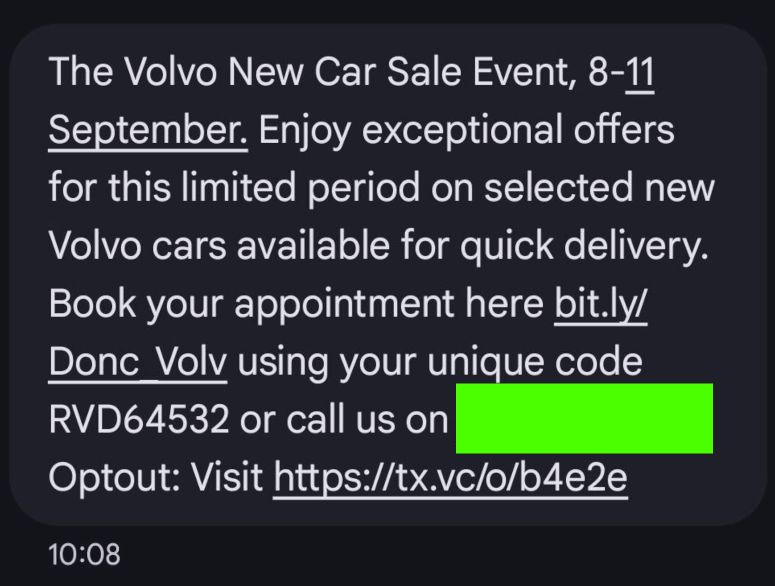
The message gives everything needed to act, including what (car sale), when (September 8–11), how (book appointment via link or call), and why (exceptional offers, quick delivery).
The unique code personalizes the mass message and helps Volvo track which customers came from this SMS campaign.
The takeaway
Use SMS for time-sensitive offers with clear next steps. Include tracking codes to measure performance, offer multiple response options, and state the value proposition early.
2. Sony — TikTok product result showcases
Sony showcases cameras on TikTok to help customers with purchase decisions. Jake’s Kando Trip photos scroll in reel format, showing RX1R III results that buyers want to see before spending thousands:
@sony Our Creator Highlight of the Week goes out to @Jake for capturing these beautiful shots with the RX1R III at Sony Kando Trip 📸 #Sony #SonyAlpha #SonyElectronics #SonyKandoTrip ♬ original sound – Sony
Mobile marketing works here because TikTok users search hashtags like #SonyAlpha on their phones while shopping. They find creator posts with sample images, compare different cameras, and make buying decisions based on what photographers produce.
The takeaway
Feature your customers’ results on platforms where buyers search for them. UGC (user-generated content) showing your product in action builds more trust than any promotional post.
3. eBay — push notifications for urgency
eBay creates shopping urgency with countdown notifications for watched items. When auctions approach their end, the lock screen shows times remaining, whether two minutes or 15, alongside product photos of the tracked items:
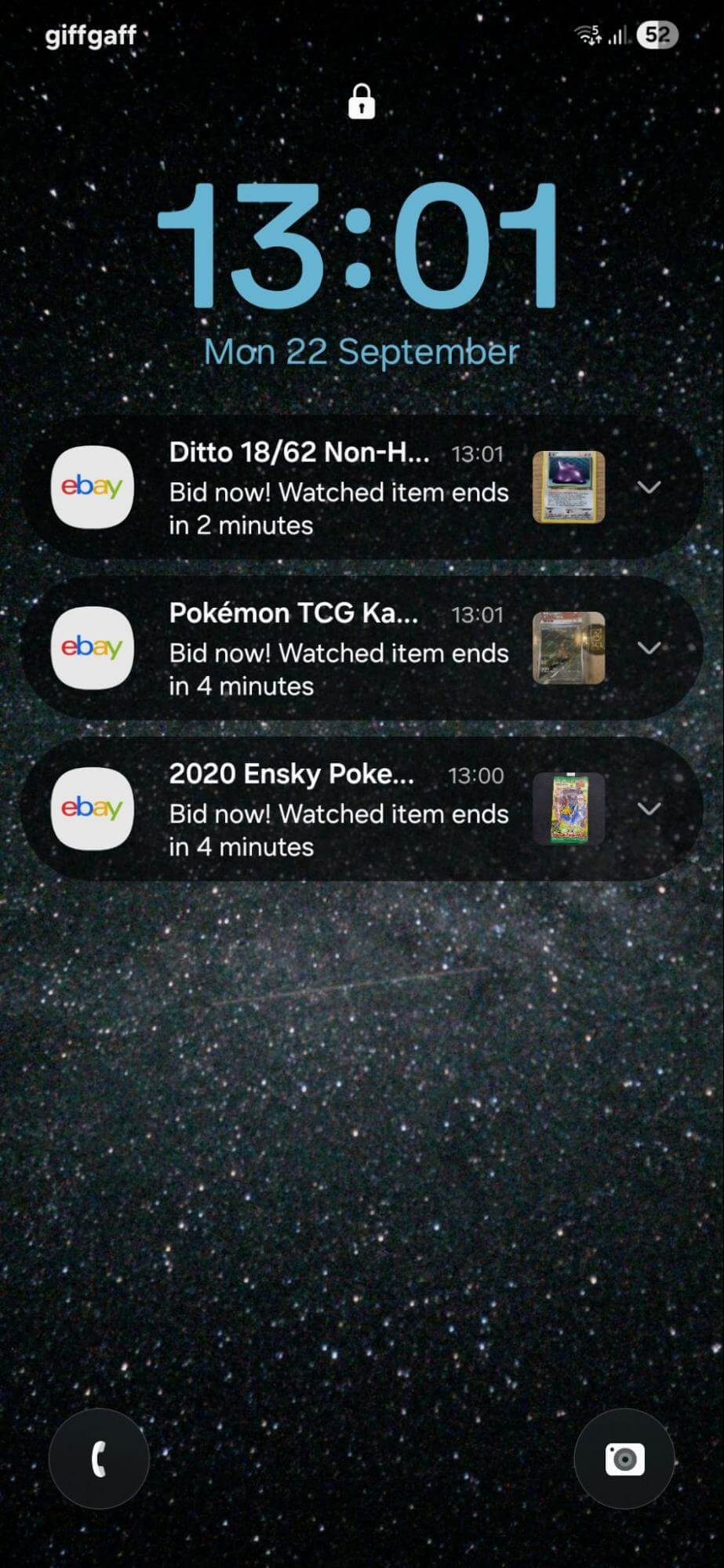
These notifications are effective because watchers have already invested attention. They added items to watch lists, compared prices, and maybe placed bids. Now the notification catches them at work or home when they can still act before someone else wins.
The takeaway
Send push notifications for time-based constraints in your business. Inventory running low, shipping cutoffs approaching, or sales ending soon all warrant mobile alerts.
Link the countdown to constraints that matter, like “order within two hours for same-day delivery” or “three items left in your size.”
4. Sephora — personalized app content
Sephora turns shopping tasks into a point-earning game. Its Beauty Insider Challenges offer 500 bonus points for completing four activities that teach app features. The ladder visual and celebration graphics make earning feel like winning:
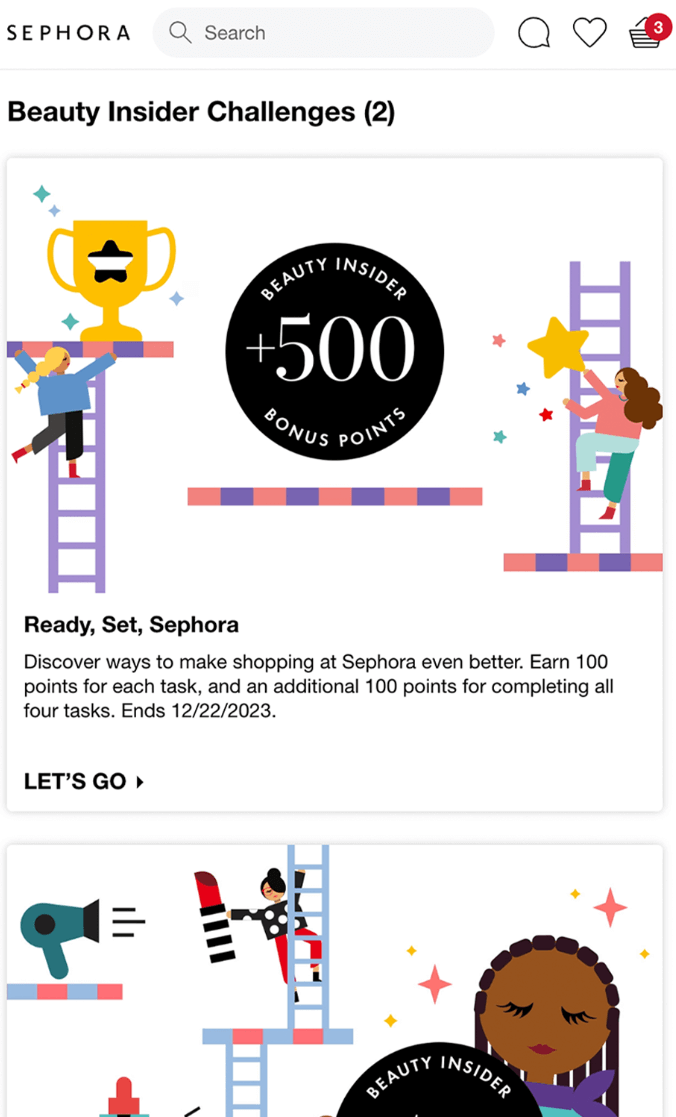
Additionally, personalized product feeds show items based on purchase history, while 24-hour early access creates app-only exclusivity:
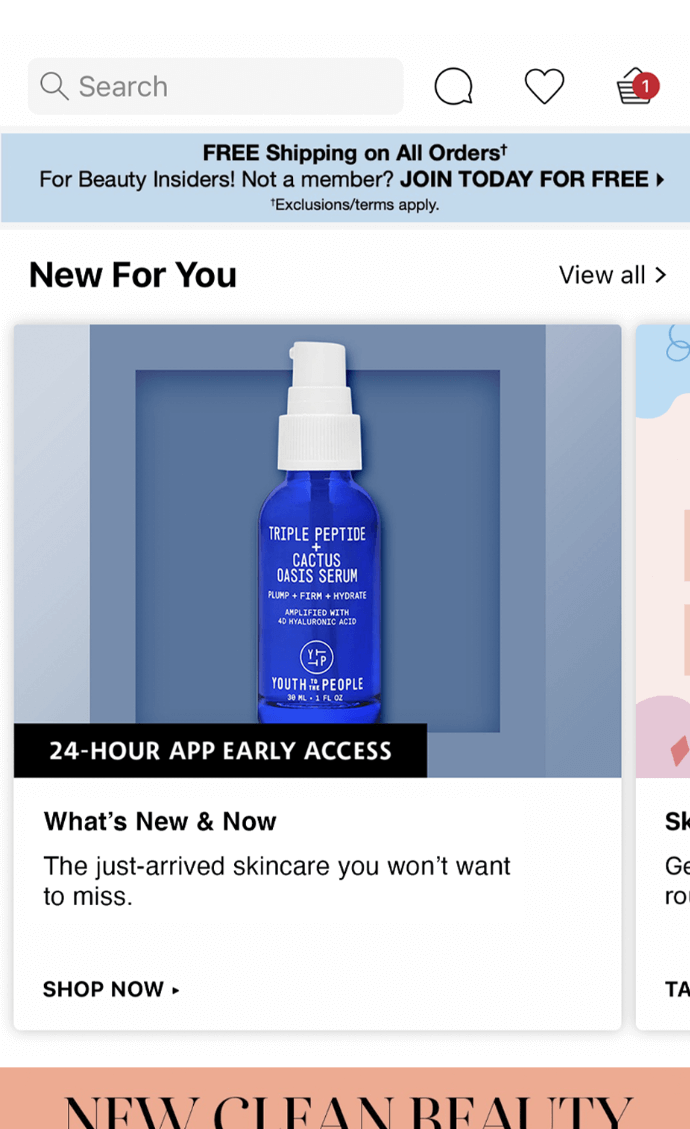
When customers chase points for updating profiles or browsing categories, Sephora gets the engagement data it needs while shoppers feel rewarded:
The takeaway
Notice how Sephora gets customers to volunteer information they’d usually ignore giving. You win when profile fields become point opportunities, when push permissions reveal perks, and when browsing data earns rewards. Make your data needs their next achievement to gain.
Mobile-first marketing strategy and the future of mobile
Your customers shop on phones while waiting for coffee, lying in bed, and sitting on trains. Desktops are for work, smartphones are for buying, and the gap is growing as more people shift their habits.
What’s changing now:
- Social commerce turns Instagram and TikTok into checkout points
- Voice shopping lets customers reorder with “Alexa, buy more coffee pods”
- AR shows products in your space before you buy
- Digital wallets replace typing card numbers repeatedly
What’s coming next:
- AI mobile shopping assistants
- RCS messaging with product carousels and payment buttons built in
- Biometric payments using face or fingerprint instead of passwords
- Location-aware offers with exclusive discounts, such as restaurant SMS
What wins:
- Websites that load in two seconds
- Messages sent when customers are active
- Checkout flows that remember previous orders
- Mobile-first design, not desktop squeezed onto phones
Build your mobile marketing with tools that handle complexity while you focus on strategy — Omnisend automates SMS, email, and push notifications based on customer behavior patterns.
Quick sign up | No credit card required
TABLE OF CONTENTS
TABLE OF CONTENTS


No fluff, no spam, no corporate filler. Just a friendly letter, twice a month.

 OFFER
OFFER







